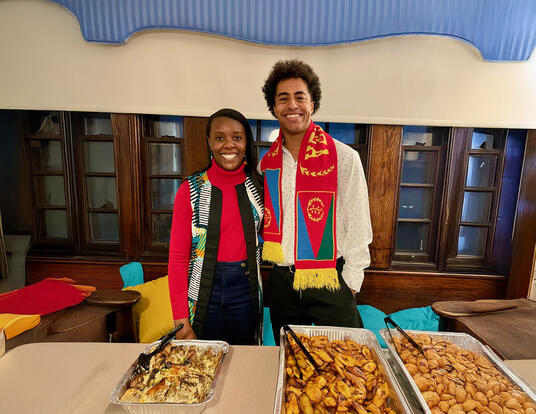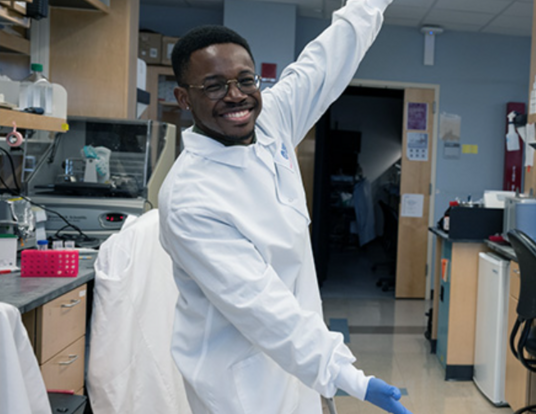Running with Scissors
How the shape of shears can improve the shelters we build and the clothes we wear
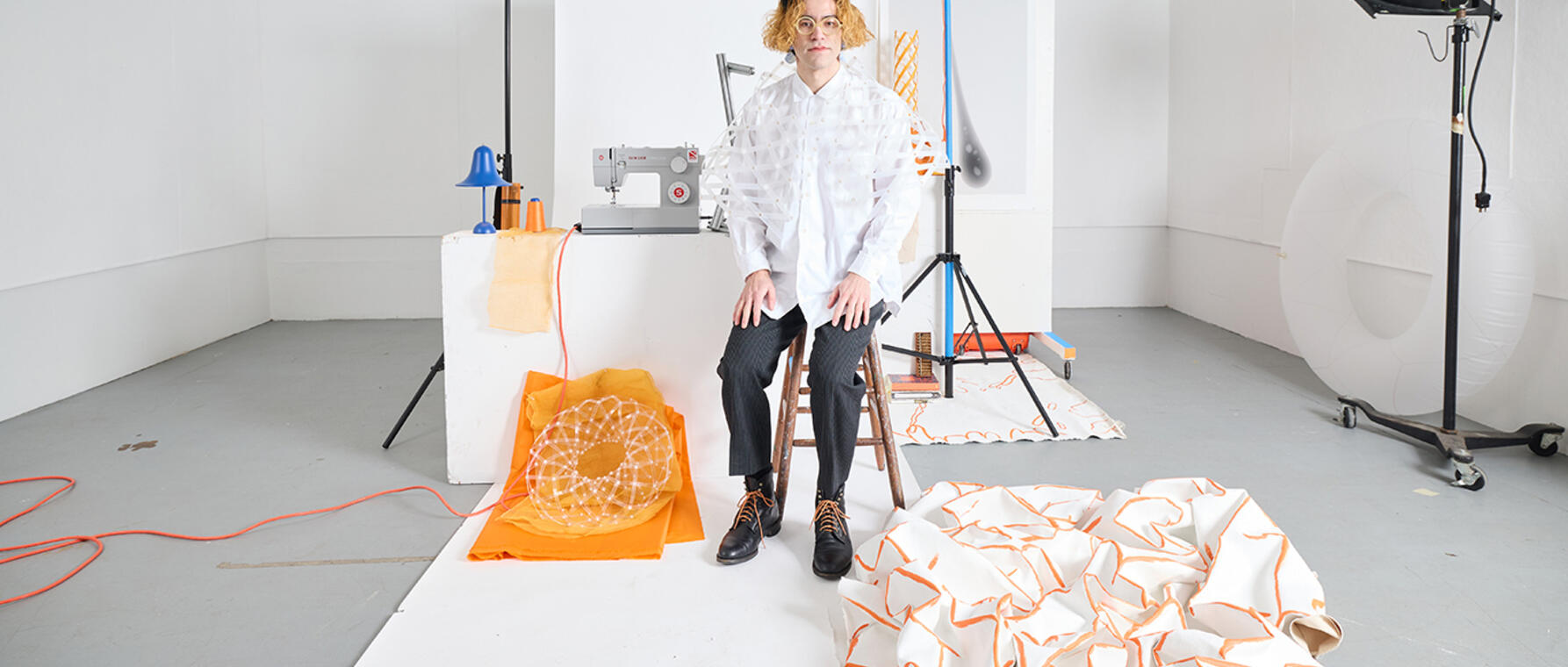
Research at Risk: Since World War II, universities have worked with the federal government to create an innovation ecosystem that has yielded life-changing progress. Now much of that work may be halted as funding is withdrawn. Find out more about the threats to medical, engineering, and scientific research, as well as how Harvard is fighting to preserve this work—and the University's core values.
Geometry, biology, architecture, and fashion may seem like wildly disparate fields but they all meet in the work of PhD physics student Noah Toyonaga—not unlike the shape that lies at the center of their research.
“Most people have played with or used a pair of scissors,” they say. “And if we take this shape seriously at the level of physics and look out into the world, it turns out you can find it all over the place.”
Toyonaga, who uses they/them pronouns, explores the familiar mechanism of the “two-bar linkage” across different areas of knowledge and creativity—not actual scissors, but a geometric motif featuring two bars connected at a central pivot point that facilitates a shearing motion. Through study and imagination, Toyonaga takes a simple shape and envisions new applications in the shelters we build and even the clothes we wear.
From the Elementary to the Extraordinary
Toyonaga works with what is essentially a lattice of scissors, connected from handles to tips. An everyday example is a bathroom mirror with an extendible metal arm that uses a one-dimensional lattice. Toyonaga’s lattices are two-dimensional, featuring scissors connected horizontally and vertically, allowing them to expand and contract on multiple planes. “To me, this set of projects is beautiful and interesting, because they show the breadth you can get from simple geometric ideas—this pair of scissors is so elementary,” they say.
Toyonaga initially encountered the scissors motif in a microbiological contractile injection system—essentially a mechanical spring viruses and bacteria use to infect their hosts. From there, they developed a set of algorithms to create various new shapes by altering the length of the connecting legs. What resulted was an entirely new class of meta-material, similar to origami or kirigami (the traditional Japanese art of cutting and folding paper), that uses pivot points instead of folds to create new structures. Such structures retain their ability to transform between one-dimensional and three-dimensional, creating possibilities for transportable architectures, such as emergency shelters or moveable hospitals. “When it becomes possible to fold up any structure to a fraction of its size,” Toyonaga says, “we begin to think differently about space and how we move through it.”
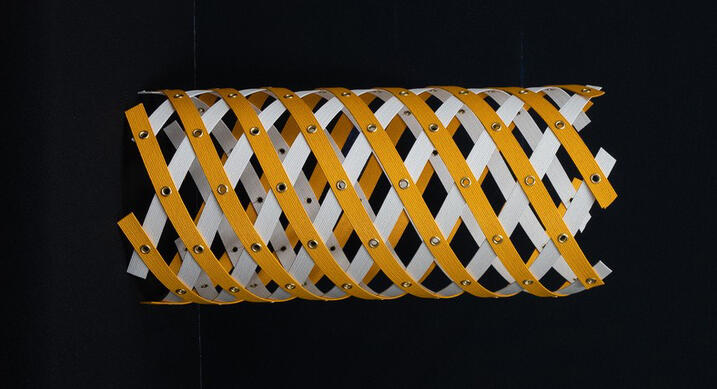
Katia Bertoldi, the William and Ami Kuan Danoff Professor of Applied Mechanics and one of Toyonaga's faculty advisors, says this work is breaking new ground. "Noah has identified a new class of morphable lattice structures, 'amigami,' that contribute to the field of origami/kirigami metamaterials. His structures may have a variety of uses across architecture, physical computing, and more.”
Toyonaga has also observed the scissors lattice in the crisscrossing warp and weft fibers in woven fabric. Fascinated by how fabrics wrap around bodies and when and how wrinkles are created, they now explore applications in areas that draw on traditional weaving patterns, such as haute couture and carbon fiber patterning, the latter of which is used in objects as diverse as fishing rods and spacecraft. Toyonaga’s current research combines geometry with design for use on the scale of clothing and garments.
“In many ways, we’re more complicated than buildings, which stay still,” they say. “We move, and we’re all different shapes, and we change shape over the course of the day and the course of years. It’s kind of remarkable that we found sets of substances, like textiles and leathers, out in the world that could move with us.”
Clothing presents what Toyonaga calls “a wonderfully complicated problem” of geometry: How to make a garment that fits well. To answer that question, they are conducting a mathematical examination of pattern drafting. Additionally, they have received a grant through critical media practice, a secondary field for Harvard PhD students who wish to integrate media creation into their academic work, to design garments that incorporate the scissor lattices as part of their art practice.
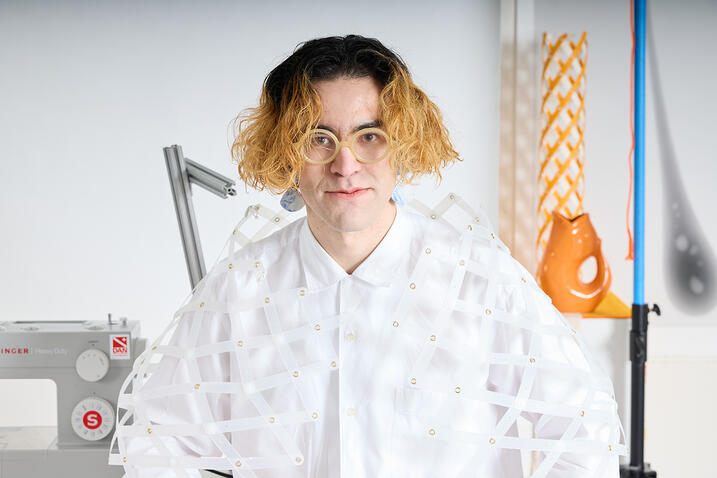
“How do we design the patterns we cut to accommodate those substances that can move with us?” they ask. “That question is coupled with ones of regulating body temperature, and with aesthetic concerns. Clothing articulates something about us but also has to be deeply functional. It’s one of the ways that geometry has always been around us without serious academics paying a lot of attention to it. But people who sew have been caretakers of this incredible knowledge for millennia.”
Fun and Tasty
Playful curiosity, often seen as trivial or even decadent, is the force behind Toyonaga’s inquiries at Harvard’s Soft Math Lab, which uses “experiments, theory, and computation to study motion and matter at the human scale,” and where they do much of their research. They say their work is driven by one simple question: Is this project fun and interesting?
“My advisor, Professor L. Mahadevan, teaches me that you need to shut off the part of your mind that asks, ‘Is this important?’ in the abstract sense and just pay attention to whether there is some interesting phenomenon going on here,” they say. “And then you pull back from that. Almost always there is something important.”
Appropriately, Toyonaga’s academic journey followed a winding path through topics that attended to beauty and joy. They credit their high school teacher, John Danssaert, and college supervisor, Stanford Professor Steven Chu, for supporting their interest in physics and embodying joyful enthusiasm for what they taught.
“Both of these people were able to articulate or share something about what they saw in this way of thinking through play,” they say. Through their approach to teaching, both mentors showed Toyonaga that research could be fun, leading them to pursue a PhD in physics. “I'm like the famous experiment where they put marshmallows in front of kids and tell them they can eat it now or wait a bit and get two marshmallows. It’s like, ‘Oh, this looks fun and tasty! I want to have this, too!’ And so, this is how I ended up continuing to do physics.”
One of Toyonaga’s undergraduate advisors, Hans Ulrich Gumbrecht, Albert Guérard Professor of Literature at Stanford, observed that this mental flexibility kept Toyonaga open to new insights. “At Stanford, Noah Toyonaga impressed me with a mind that combined a mathematical and classical science-type rigor, as its matrix and dominant form, with a fascination both for philosophical arguments and the flights of imagination, triggered by literary texts. Rather than trying to merge these different intellectual styles to a blurry state of non-distinction, Noah was willing and able to use conversations in the world of the humanities and arts as inspiration for often original intuitions.”
Playful engagement with the ideas and materials of the Soft Math Lab is ultimately what led Toyonaga to their current Harvard Horizons project. After reading a paper that attempted to model contractile injection, Toyonaga was inspired to start playing with models of the system.
“I was making these models just because I wanted to play with the toy,” they say. “I think I still have the original model I made when I was at my friend's house for dinner, and I was like, ‘I’ve got to make this thing!’ My friend helped me punch holes in plastic strips and tied them together.”
Although the model was rudimentary, playing with it inspired Toyonaga to see how manipulating the shape could create something new. “I thought, it would be kind of interesting if I changed this from a regular grid, where all the lengths are the same,” they say. “If you begin to change the lengths, maybe you can do something different.”
As a result of making and playing with the model, Toyonaga discovered that the lattice could transform from a straight tube to a closed donut shape, and, with the rest of the research team, developed algorithms that could design numerous structures simply by using interconnected scissors shapes, including any object that is symmetrical around an axis, such as a vase or donut.
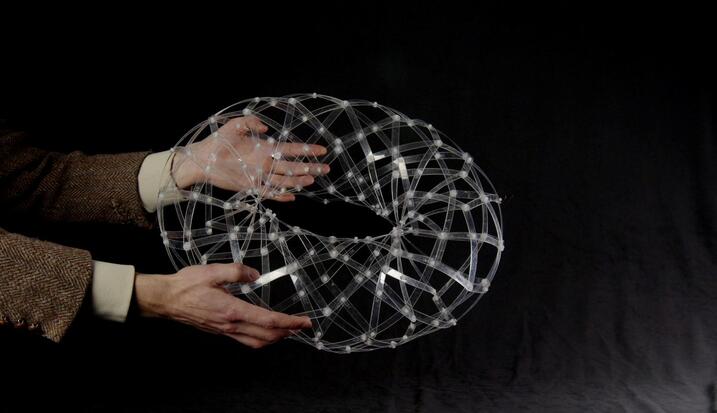
To Illuminate the Everyday
Toyonaga values questions that pique their curiosity and draw their focus to the world around them. Going forward, they hope to shine a light on everyday beauty.
“I do think that we should pursue things because they’re beautiful because we want to share that with other people,” they say. “To me, garments are an interesting domain in which to think about this, because everyone interacts with clothes every day. If we can just bring physics and our attention to the beauty of this thing that we’re always surrounded by, to me, that has achieved the goal.”
Toyonaga plans to publish their research—including the code behind the algorithm they developed—so that others can better understand and work with it themselves. But they say they don’t expect most people to be interested in that kind of exploration. They have a much simpler aspiration for the impact of their ideas moving forward.
“I do hope that people will interact with the garment I’ll be making over the next year,” they say. “I want them to see it and think, ‘That’s kind of fun!’ To me, that’s total success; someone paused and for a second saw the wonder in something mundane.”
Learn more about the 2024 Harvard Horizons Scholars and see them on stage at the campus-wide Harvard Horizons Symposium in Sanders Theatre on April 9.
Get the Latest Updates
Join Our Newsletter
Subscribe to Colloquy Podcast
Simplecast



